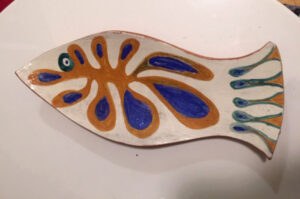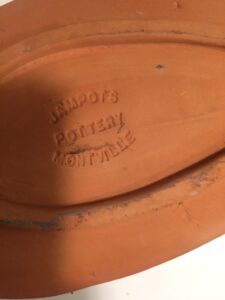 Let me tell you a story of a theme and technique championed by none other than Pablo Picasso adopted in the Hinterland of Australia.
Let me tell you a story of a theme and technique championed by none other than Pablo Picasso adopted in the Hinterland of Australia.
Check out FT’s ceramic fish plate. The markings read “Jampots Pottery, Montville.” From 1966-1998 Montville pottery stood in Montville, Sunshine Coast, Queensland, Australia. So how did a ceramic so genuinely like a Picasso become made in the Hinterland?
Picasso would have felt proud. The Hinterland is the traditional lands of the Aboriginal Gubbi Gubbi people. Captain Cook ‘first’ discovered the area, as he surveyed the mountain range from his ship, The Endeavor. That mountain range with sections that stood up like furnaces reminded Captain Cook of his home in England, and of the Glass House furnaces.
Ironically, we find the elements for good clay in such regions, both in England and in the Hinterland. We know the minerals from such rock formations come from magna intrusions. These mountains were formed 25 million years ago. Although Captain Cook named them, they had a name well before 1770; ”daki comon” in the Aboriginal language, “stone standing up.”
Through the Lens of Tribal Patterns
Picasso used tribal elements. Remember les Demoiselles d’Avignon (1907), nude women with tribal mask faces? Likewise, in the early 1960s potters in the Hinterland also saw images through the lens of tribal patterns.
I learned the Hinterland is comprised of the Pacific Ocean views, rainforests, the Glass House Mountains, and the towns of Flaxton, Mapleton, Maleny, and Montville. An ancestor of FT, who hung out with the potters of Montville, collected this fish plate in Montville. There’s not a lot of information about the Pottery Montville, but I did find a few facts.
Fish Plate Origin
 The Pottery Montville became the first craft endeavor on the Sunshine Coast, founded by English immigrants Doug and Audrey Everett in 1961. Imagine leaving England as a young couple and starting a pottery kiln!
The Pottery Montville became the first craft endeavor on the Sunshine Coast, founded by English immigrants Doug and Audrey Everett in 1961. Imagine leaving England as a young couple and starting a pottery kiln!
Since the 1960s the little pottery had many owners, each with their own brand of Terre de faience, terracotta with colorful high glaze that ‘sits’ on top of the pottery. Thus, many artists threw pots at Montville Pottery and sold to the tourists in the 1960s and 1970s. In the late 1980s the town Montville came up with a brilliant idea. To put the town on the tourist map, they decided to demolish the Pottery, and build a complex of artist’s studios to attract visitors to the ‘artistic’ town. They tore down the whole Pottery, and because the Artist’s Community Block needed a name, if you visit Montville today, you find a craft complex called The Pottery Building.
In any event, FT, who inherited his plate, asked if he REALLY DID have a Picasso Madoura piece. To him it looks so like Picasso’s ceramics. Well, most Picasso ceramics have the imprint: “Emprint Originale de Picasso” and the Madoura mark (Picasso’s potter).
I see why FT hoped this Australian look-alike from the Hinterland might have been in fact a Picasso piece of Madoura.
Let’s compare values
Out of Earthenware clay, with a faience glaze, we find a dinner service by Picasso of hand painted faience, attributed by the scholar Alain Raime (1988) in the Catalogue of the Edited Ceramic Works of Picasso 1947-1971. We see the value today of the twenty-six pieces at $137,000. Next, we see a Picasso Unique Plat Poisson Ceramic, a little platter not unlike the one FT inherited, made in 1952, selling for $58,000. No wonder FT asked for my opinion!
Alas, I must quote to FT Picasso’s favorite expression: “Every act of creation is, first of all, an act of destruction.” Now comes the destruction: FT, the fish earthenware and faience dish is NOT by Picasso. Some very talents Hinterland artists made it in the 1960s. They channeled the spirit of the artist with a tremendous impact on 20th century modern art. People associate Picasso with the Cubist movement, through his friend Georges Braque, who influenced Surrealism, Neoclassism, and Expressionism, and who deconstructed our way of looking at the world. Picasso made 20,000 works of art, so I understand FT’s optimism that he owned something by this great artist.
The abstraction of FT’s fish plate reminded him of the portrait Picasso did of his first wife Olga: Woman with a Hat (Olga) 1935. In this painting Olga’s face is simply abstracted lines that call to mind the structure of both her and her personality.
So, FT you have a merging of cultures, and a little plate that is in the shape, the reason, and the way a fish IS. The value is $300.